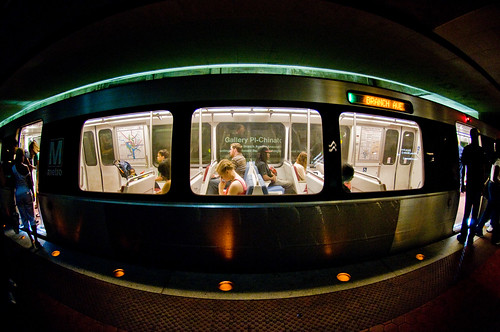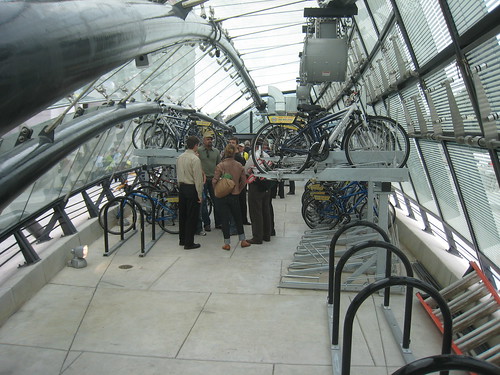(Source: New York Times, Washington Post & CNN.com)

Image Courtesy: The Associated Press - Picture from Accident Scene
At least nine people were killed (as of local reporting time 11:35PM) and roughly 20 injured when one Metro subway train slammed into another on the outskirts of the city during the afternoon rush hour on Monday, emergency officials said. At the scene, one subway car sat fully on top of a car from the other train. The car on top had part of its floor sheared off, and the wreckage was a jumble of twisted metal. Seats from the smashed cars had spilled onto the tracks.
The crash occurred around 5 p.m. on a heavily traveled Metro route, known as the Red Line, that shuttles thousands of commuters every day from the suburbs into the city. It occurred between the Takoma Park and Fort Totten stations, where there is a long stretch of track, meaning trains often reach high speeds.
Several passengers were carried off on stretchers, and rescue crews used ladders and heavy equipment to cut into the wreckage and get to passengers stuck inside. Helicopters buzzed overhead. The police scrambled to coordinate traffic, onlookers and the rescue workers.
Emergency medical personnel set up a triage site at the nearby Jarboe Printing Company. Mr. Catoe said there were about 75 passengers on the two trains. Six people were seriously injured, 14 had non-life-threatening injuries and about 50 appeared to be unharmed. Passengers said about 15 minutes passed before officials showed up or any announcements were made.
Details and Possible Causation Analysis
Investigators will probably focus on a failure of Metro’s computerized signal system, which is designed to prevent trains from coming close enough to collide, as well as operator error, according to former Metro officials.
The system relies on electronic relays — about the size of a hardcover book — aboard trains and buried beside the tracks along each line. When a train gets too close to another train, the system is designed to automatically stop the approaching train. It should work regardless of whether trains are being operated manually or by computer.
Metro has had trouble with its signal system in recent years, and replaced all 20,000 trackside relays in 2000 after discovering that a small portion were failing.
But even if the signal system failed to stop the train, the operator should have intervened and applied emergency brakes, safety experts familiar with Metro’s operations say. The position of the second train after the crash — the fact that its first car came to rest atop the other train — indicates that the second train was traveling at high speed. In the section of track where the accident occurred, the maximum speed is supposed to be 58 mph. Metro officials would not say how fast the trains were going because of the ongoing NTSB investigation.
Stories of crash victims
A survivor, Jodie Wickett, described feeling a bump on the track, and then being flung forward when the train suddenly halted a few seconds later. She said she hit her head, but managed to get out and go to where the collision occurred a few cars up, where one subway car lay atop another.
“It was a huge impact,” said Maya Maroto, 31, of Burtonsville, Md., who was in the third car of the moving train as she headed into the city to see a movie. “Our first inclination was that we hit another train or car.” An elderly woman sitting near them flew out of her seat and landed sprawled on the floor. Ms. Maroto said she did not realize the seriousness of the accident until she looked out the door and saw the front of her train wedged on top of the other one. Minutes later she looked again and saw a body on the tracks.
Jasmine Gars, who also was on the moving train, told CNN’s “Larry King Live” that the collision “was like nothing I’ve ever felt before.” “It was like we hit a concrete wall,” Gars said. “Almost immediately I fell off my seat. Another person — I don’t know who — flew off their seat. And the lights went off and smoke started filling the train car.”
Tom Baker, 47, a District resident, was in the first car of the second train, which rear-ended the first one and landed on top of it. There were eight to 10 passengers in his car. As they pulled out of Takoma on the way to Fort Totten, the female operator said the train was holding because there was a train in front of them. Shortly thereafter, the train started moving again, but within a minute, there was an “enormous crashing jolt,” he said.
“You could hear all this crashing and glass breaking,” Baker said. “I didn’t hear any brakes at all.” He said he couldn’t gauge how fast the train was moving but said it was traveling at moderate speed. He saw the train lift into the air, he said. “When the dust settled, the entire front of the train was gone,” and riders could see down to the train below them.
Great Safety Record Now Tarnished

Image Courtesy: Washington Post - Staff reports, National Transportation Safety Board, Washington Metropolitan Area Transit Authority. (Please note the death toll has now been revised to 9; it was 6 at the time this graphic was published)
The accident was the second involving passenger fatalities in the history of the system. In 1982, three people died after a train derailed between the Federal Triangle and Smithsonian stations. In 2004, two Metro trains collided at the Woodley Park-Zoo/Adams Morgan station, resulting in minor injuries.
This is the third serious Metrorail crash since 1996. The last fatal train crash was in 1996, when a Red Line train overshot the Shady Grove platform on an icy night and plowed into another train. The operator died. In November 2004, a Red Line train rolled backwards down a steep stretch of track and smashed into another train at the Woodley Park station. Twenty people were injured but there were no fatalities.
The deadliest accident in the system’s history occurred in 1982, when a six-car Orange Line train bound for New Carrollton derailed near the Smithsonian Station when an improperly aligned switch caused it to enter the wrong track. Three passengers were killed.
Tom Baker, 47, a District resident, was in the first car of the second train, which rear-ended the first one and landed on top of it. There were eight to 10 passengers in his car. As they pulled out of Takoma on the way to Fort Totten, the female operator said the train was holding because there was a train in front of them. Shortly thereafter, the train started moving again, but within a minute, there was an “enormous crashing jolt,” he said.
“You could hear all this crashing and glass breaking,” Baker said. “I didn’t hear any brakes at all.” He said he couldn’t gauge how fast the train was moving but said it was traveling at moderate speed. He saw the train lift into the air, he said. “When the dust settled, the entire front of the train was gone,” and riders could see down to the train below them.
Officials React
“It looks to be the worst Metro accident in D.C. history,” said MayorAdrian M. Fenty. “We’re going to investigate this and find out what happened.”
The general manager of the Metro system, John B. Catoe Jr., said one train had stopped near a platform and was waiting for permission to proceed when it was hit from behind by the second train.
Mr. Catoe did not speculate on whether safety devices intended to prevent such crashes had failed, saying the authorities were still focused on rescuing passengers.
President Obama issued a statement saying he and his wife Michelle were “saddened by the terrible accident,” and thanking the first responders to the scene “who arrived immediately to save lives.”
Click here to view videos related to the story. Click here to read the latest updates from the scene.
Breaking News Update: One of the local news channels (Channel 9) reported a few minutes ago that the death toll has now jumped to 9 and a few people continue to be listed as “critical.”
 were recently approved by the U.S. Dept. of Homeland Security. Grants also include money for 20 additional transit police officers, 3 bomb-sniffing dog teams and security training for 9,000 “front line” employees. The lion’s share of of the grant money will be spent on enhanced video surveillance of Metro’s sprawling rail and bus system.
were recently approved by the U.S. Dept. of Homeland Security. Grants also include money for 20 additional transit police officers, 3 bomb-sniffing dog teams and security training for 9,000 “front line” employees. The lion’s share of of the grant money will be spent on enhanced video surveillance of Metro’s sprawling rail and bus system.












